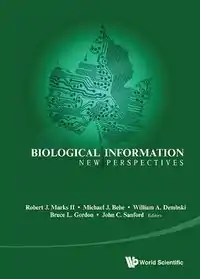Biological Information: New Perspectives
Biological Information: New Perspectives was a conference held by creationists and other cdesign proponentsists May 30 - June 2, 2011 in Ithaca, New York.[1] It wasn't heavily advertised, indeed, it seemed to be an invitation-only event, so it would have been lost in obscurity if the organizers hadn't nearly succeeded in getting the Springer Verlag
“”In the spring of 2011, a diverse group of scientists gathered at Cornell University to discuss their research into the nature and origin of biological information. This symposium brought together experts in information theory, computer science, numerical simulation, thermodynamics, evolutionary theory, whole organism biology, developmental biology, molecular biology, genetics, physics, biophysics, mathematics, and linguistics. This volume presents new research by those invited to speak at the conference.
|

| The divine comedy Creationism |
| Running gags |
| Jokes aside |
| Blooper reel |
v - t - e |
Besides being filled with the typical phrases, this announcement — probably written by the editors of the proceedings Robert J. Marks II
Published at Last
World Scientific Publishing
Content
Session One — Information Theory and Biology:
- Introductory Comments (R J Marks II)
- Biological Information — What is it? (W Gitt, R Compton and J Fernandez)
- A General Theory of Information Cost Incurred by Successful Search (W A Dembski, W Ewert, and R J Marks II)
- Pragmatic Information (J W Oller Jr)
- Limits of Chaos and Progress in Evolutionary Dynamics (W F Basener)
- Tierra: The Character of adaptation (W Ewert, W A Dembski and R J Marks II)
- Multiple Overlapping Genetic Codes Profoundly Reduce the Probability of Beneficial Mutation (G Montañez, R J Marks II, J Fernandez and J C Sanford)
- Entropy, Evolution and Open Systems (G Sewell)
- Information and Thermodynamics in Living Systems (A C McIntosh)
Session Two — Biological Information and Genetic Theory:
- Introductory Comments (J C Sanford)
- Not Junk After All: Non-Protein-Coding DNA Carries Extensive Biological Information (J Wells)
- Can Purifying Natural Selection Preserve Biological Information? (P Gibson, J R Baumgardner, W H Brewer and J C Sanford)
- Selection Threshold Severely Constrains Capture Of Beneficial Mutations (J C Sanford, J R Baumgardner and W H *Using Numerical Simulation to Test the “Mutation-Count” Hypothesis (W H Brewer, J R Baumgardner and J C Sanford)
- Can Synergistic Epistasis Halt Mutation Accumulation? Results from Numerical Simulation (J R Baumgardner, W H Brewer and J C Sanford)
- Computational Evolution Experiments Reveal a Net Loss of Genetic Information Despite Selection (C W Nelson, and J C Sanford)
- Information Loss: Potential for Accelerating Natural Genetic Attenuation of RNA Viruses (W H Brewer, F D Smith and J C Sanford)
- DNA.EXE: A Sequence Comparison Between the Human Genome and Computer Program Code (J Seaman)
- Biocybernetics and Biosemiosis (D Johnson)
Session Three — Theoretical Molecular Biology:
- Introductory Comments (M J Behe)
- A New Model of Intracellular Communication Based on Coherent, High-Frequency Vibrations in Biomolecules (Dent L)
- Getting There First: An Evolutionary Rate Advantage for Adaptive Loss-of-Function Mutations (M J Behe)
- The Membrane Code: A Carrier of Essential Biological Information That is Not Specified by DNA and is Inherited Apart from It (J Wells)
- Explaining Metabolic Innovation: Neo-Darwinism Versus Design (D Axe and A Gauger)
Session Four — Biological Information and Self-Organizational Complexity Theory:
- Introductory Comments (B Gordon)
- Evolution Beyond Entailing Law: The Roles of Embodied Information and Self Organization (S Kauffman)
- Hierarchical Information Theory and the Modeling of Biological Systems (J D H Smith)
- Towards a General Biology: Emergence of Life and Information from the Perspective of Complex Systems Dynamics (B H Weber)
External links
- Wesley R. Elsberry collected the various sources on the conference for Panda's Thumb.
- Nick Matzke sums up the conference at Panda's Thumb.
- Springer's version of Biological Information: New Perspectives at Amazon.com — out of print because Springer gave it the kibosh before it was too late to keep copies from leaking out
- World Scientific's version of Biological Information: New Perspectives at Amazon.com
Notes
- I.e., meaning either 'terminal' or 'goal-directed', referencing teleology, and thus 'guided evolution)'.
References
- announcement of stipends for student participants from Baylor University